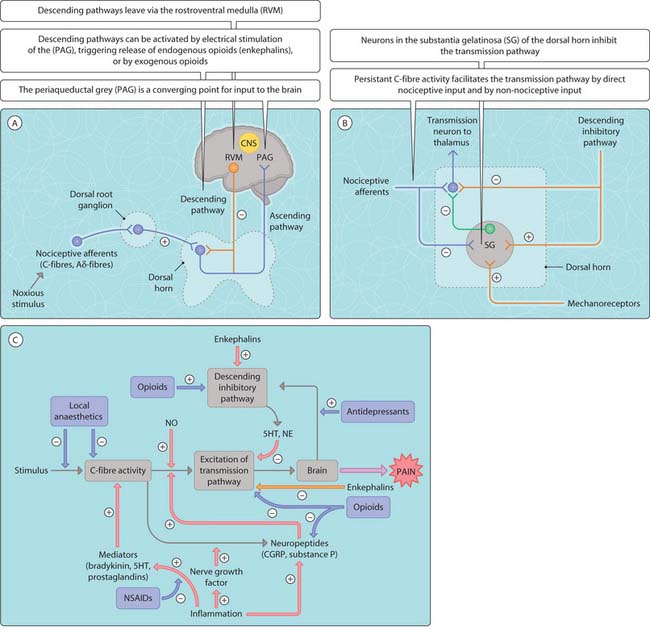41 Treatment of pain
The perception of pain is a normal defence mechanism in order to avoid further harm. Pain arising under pathological situations (e.g. neuropathic pain) can be seriously debilitating and is characterized by an increase in perception of innocuous (allodynia) or noxious (hyperalgesia) stimuli. Peripheral sensory nerve endings (C, Aδ) present in the skin and viscera respond to mechanical, chemical or thermal stimuli. The activation of these neurons results in the release of neuropeptides and glutamate from their terminal endings in the vicinity of dorsal horn neurons (laminae I, II, IV–VI). The release of neuropeptides and glutamate from the spinal terminals of these afferent nerves activates dorsal horn neurons that, in turn, relay neurotransmission centrally where pain is perceived (Fig. 3.41.1). Acute or chronic pain is a consequence of an increase in pain neurotransmission. Endogenous opioids regulate pain transmission by (a) activating supraspinal regions (e.g. thalamus) and thereby reducing pain perception; (b) activating the periaqueductal grey and rostroventrial medulla (VRM) and thereby increasing the inhibitory activity of the descending pathway; (c) directly inhibiting dorsal horn neurons by enkephalin-releasing interneurons; and (d) inhibiting neuropeptide and glutamate release from peripheral sensory nerves synapsing with dorsal horn neurons. Endogenous opioids regulate pain transmission by activating G-protein-coupled receptors present on spinal and supraspinal nerves. There are three receptor subtypes, μ (mu), κ (kappa) and δ (delta), which are activated by endogenous opioids (e.g. met-enkephalin,β-endorphin). The μ receptor subtypes mediate most of the analgesic actions of opioids.

Fig. 3.41.1 Pain. (A) Pathways; (B) gate control in the dorsal horn; (C) modulation of the pain pathway.
Opioids
A variety of synthetic opioid analogues based on the structure of the naturally occurring opioid morphine have clinical efficacy in the treatment and management of pain (Fig. 3.41.1C). These agonists are relatively selective for and bind reversibly to opioid m receptors, which couple to potassium channels and result in membrane hyperpolarization, reduced neuronal excitability and inhibition of neurotransmitter release (e.g. neuropeptide, glutamate). In contrast, local anaesthetics and NSAIDs (but not opioids) reduce pain by inhibiting nerve conduction and sensitization of peripheral nerve endings by prostaglandins, respectively. There are a number of different structural classes of opioid receptor agonist (see below). While opioids are generally used for analgesia, there are examples of opioids used for other indications (e.g. constipation and cough). Examples of partial m-opioid agonists and antagonists include buprenorphine and naloxone, respectively.
< div class='tao-gold-member'>
Stay updated, free articles. Join our Telegram channel

Full access? Get Clinical Tree




